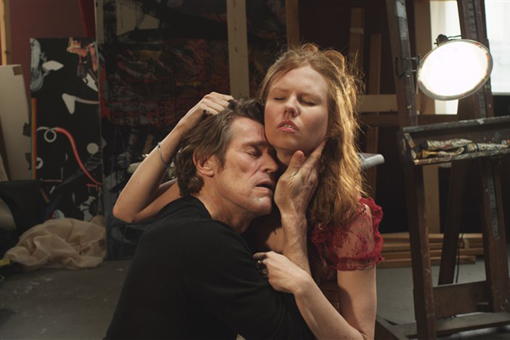By Jim Rohner · March 26, 2012

What would the end of the world look like? From what we can gather from the rooftop view of Cisco (Willem Dafoe) and Skye's (Shanyn Leigh) apartment, the end of the world in New York City largely resembles a typical holiday with a steady flow of traffic and a healthy dose of meandering bodies on the street. But the glimpses of how the masses deal with the world's destruction – prognosticated for 4:44AM EST the morning after the film begins – are peripheral and of little concern to Abel Ferrara. In 4:44 The Last Day on Earth, the writer/director foregoes the concerns of civilization and mankind in favor of focusing on the intimacy and immediacy that two people experience when awaiting their imminent destruction.
For the most part, the couple (Cisco the actor and Skye the painter) carry on as they would on any other day – Skye painting and Cisco shaving. Some of the first spoken words are a question from her to him: "Why are you doing that?" "For you," he warmly responds. It's a fleeting moment, but one posing a larger question that hangs over the rest of the film to be answered only ambiguously or subconsciously: when the end of the world is not only guaranteed, but frightfully near, what reason is there to do anything anymore?
Mankind's existence is perpetuated on the idea of building toward the future. Just take a look at the things you own and pause for a minute to realize how many purchases you've made and actions you've taken to ensure that some situation will be handled should it come up in the future. You buy a new car because you know you'll need to get somewhere. You buy food because you know you're going to be hungry. You go on dates because (to give you the benefit of the doubt) you'll want to start a family. By creating a film that will see the world's end in less than 24 hours as seen through the actions of two average citizens, Ferrara depicts for us a world in which every action is simultaneously meaningless – why paint a picture if no one will be alive to see it? – and historic – we may have witnessed the last picture to have ever been painted.
Without any future, the majority of actions depicted in the film serve the past: Cisco makes an impromptu trip to visit Noah (Paul Hipp), the brother he's not seen in years; Skye calls her mother to complain about Cisco when she finds him calling his ex-wife; an Asian delivery boy takes advantage of the couple's generosity to Skype his family back home. Some of these moments are tender, some of them are awkward. Without exception, they are all unremarkable. Because the performances of both Dafoe and Leigh are so balanced and consistent, it's easy to believe that, were it not the end of the world, Ferrara was giving us a look at any other day in their lives.
It's this seeming mundanity that lends somewhat of an answer to the unspoken questions of "why bother?" Cisco keeps on shaving and Skye keeps on painting because that's what they've done and that's what they know to do. In a film dealing with the end of existence as we know it, it's eerily cathartic to see that the way Cisco and Skye face their own demise is the same way they face everything else.